In an industry dominated by ARM and with a growing interest in RISC-V processors, Microchip Technology has chosen to carve its own path with the new PIC32A architecture, a family of 32-bit microcontrollers based on the evolution of its dsPIC line. The inevitable question is: does the world really need another 32-bit MCU?
A New Addition to the PIC32 Family
Microchip already had three well-defined families of 32-bit microcontrollers:
- PIC32M: based on MIPS cores (microAptiv, M4K).
- PIC32C: based on ARM Cortex-M (M0+, M23, M33, M7).
- PIC32A: the newcomer, based on the evolved dsPIC architecture.
With the PIC32A, the company aims to provide a “native” and high-performance alternative for users coming from the PIC24/dsPIC ecosystem, without forcing them to migrate to ARM or MIPS.
Power for the Future of Embedded Systems
The PIC32A architecture incorporates a 200 MHz core, featuring:
- 64-bit floating-point unit (DP-FPU).
- Two MAC units of 72 bits to accelerate artificial intelligence and control algorithms.
- High-speed analog peripherals: 12-bit ADC at 40 Msps, 5 ns comparators, and 100 MHz GBWP operational amplifiers.
- Support for JTAG debugging, real-time tracing, and secure boot.
This means a platform ready for edge computing, industrial systems, medical applications, and safety-critical environments.
A Natural Evolution from dsPIC and PIC24
Joe Thomsen, vice president of Microchip’s microcontroller unit, explains that PIC32A is a logical evolution from dsPIC33A, offering compatibility at the architectural level, tools, and interrupt logic. “For developers accustomed to hardware and bare metal, PIC32A will feel like home,” Thomsen says.

This contrasts with the current trend toward more software-friendly abstraction layers (as seen with ARM’s CMSIS or RTOS like Zephyr), reinforcing Microchip’s focus on total control of the hardware, ideal for electronic engineers who are closer to the signal than to high-level software.
Another MCU in a Saturated Market?
The short answer is yes, but with nuances. While ARM dominates the ecosystem with thousands of designs and RISC-V is gaining traction as an open standard, Microchip continues to offer something that many developers value: continuity, reliability, and a gradual learning curve without abandoning their tools like MPLAB X, Harmony, or the XC32 compiler.
Furthermore, the fact that PIC32A is not binary-compatible with other PIC32 series is not a real obstacle thanks to recompilation with unified tools. Only developments in assembly language will require adjustments.
Security, Traceability, and Performance: The Keys to the New PIC32A
The inclusion of elements such as ECC in Flash and RAM, self-tests (MBIST), I/O integrity control, and clock monitoring aligns it with the requirements of functional safety certifications such as ISO 26262 (automotive) or IEC 61508 (industrial).
In summary, Microchip is not launching PIC32A to compete directly with ARM or RISC-V, but to provide a solid upgrade path to its loyal PIC ecosystem users. It does so by betting on performance, efficiency, integrated tools, and a familiar development experience, while not skimping on key innovations like embedded artificial intelligence or edge security.
🔍 Key Features of the PIC32A:
- 200 MHz core with 64-bit floating-point capability.
- High-speed analog peripherals.
- Embedded security: ECC, secure boot, MBIST.
- Upward compatibility with dsPIC and PIC24.
- Ideal for bare metal designers and control systems.
📌 Will this be enough to retain its community in the face of ARM and RISC-V? Only time will tell. But undoubtedly, PIC32A comes with solid and well-integrated arguments.
Source: Microchip

